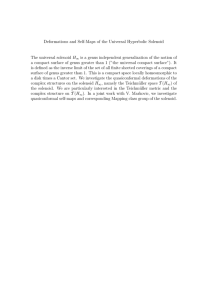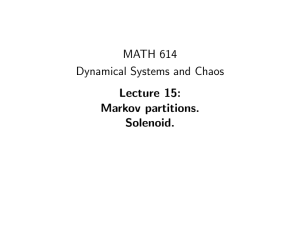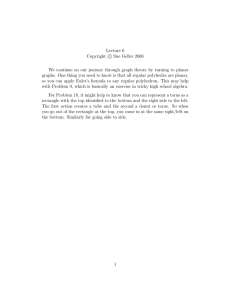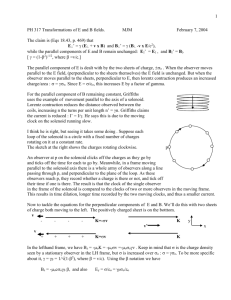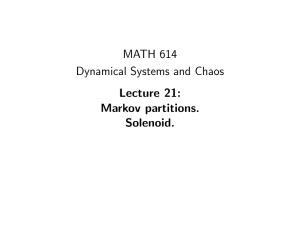MATH 614 Dynamical Systems and Chaos Lecture 22: Solenoid (continued).
advertisement
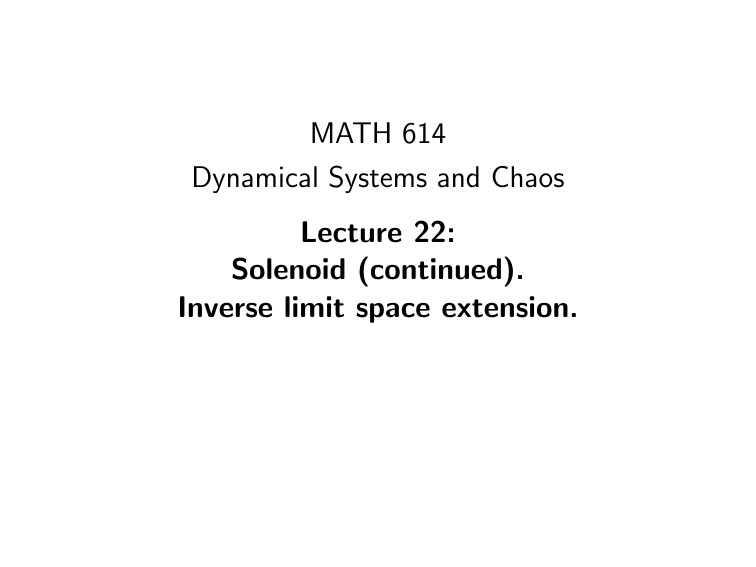
MATH 614
Dynamical Systems and Chaos
Lecture 22:
Solenoid (continued).
Inverse limit space extension.
Solid torus
Let S 1 be the circle and B 2 be the unit disk in R2 :
B 2 = {(x, y ) ∈ R2 | x 2 + y 2 ≤ 1}.
The Cartesian product D = S 1 × B 2 is called the
solid torus. It is a 3-dimensional manifold with
boundary that can be realized as a closed subset in
R3 . The boundary ∂D is the torus.
Let D = S 1 × B 2 be the solid torus. We represent the circle
S 1 as R/Z. For any θ ∈ S 1 and p ∈ B 2 let
F (θ, p) = 2θ, ap + bφ(θ) ,
where φ : S 1 → ∂B 2 is defined by
φ(θ) = cos(2πθ), sin(2πθ)
and constants a, b are chosen so that 0 < a < b and
a + b < 1. Then F : D → D is a smooth, one-to-one map.
The image F (D) is contained strictly inside of D.
The solid torus D = S 1 × B 2 is foliated by discs
B(θ) = {θ} × B 2 . The image F (B(θ)) is a smaller disc
inside of B(2θ).
It follows that all points in a disc B(θ) are forward asymptotic.
In particular, B(θ) is contained in the S
stable set W s (x) of any
s
B(θ + n/2k ).
point x ∈ B(θ). In fact, W (x) =
n,k∈Z
Solenoid
The sets D, F (D),TF 2 (D), . . . are closed and nested. The
intersection Λ =
F n (D) is called the solenoid.
n≥0
The solenoid Λ is a compact set invariant under the map F .
The restriction of F to Λ is an invertible map. The
intersection of Λ with any disc B(θ) is a Cantor set.
Moreover, Λ is locally the Cartesian product of a Cantor set
and an arc.
Properties of the solenoid
Theorem 1 The restriction F |Λ is chaotic, i.e.,
• it has sensitive dependence on initial conditions,
• it is topologically transitive,
• periodic points are dense in Λ.
Theorem 2 The solenoid Λ is an attractor of the
map F . Namely, dist F n (x), Λ → 0 as n → ∞
for all x ∈ D.
Theorem 3 For any point x ∈ Λ, the unstable set
W u (x) is a smooth curve that is dense in Λ.
Theorem 4 The solenoid is connected, but not
locally connected or arcwise connected.
Periodic points
The solid torus D = S 1 × B 2 is foliated by discs
B(θ) = {θ} × B 2 . The image F (B(θ)) is a smaller disc
inside of B(2θ).
If θ is a periodic point of the doubling map, then B(θ)
contains a unique periodic point of F (of the same period).
Inverse limit space extension
Suppose f : X → X is a dynamical system (X a compact
metric space, f a continuous map) that is not invertible. We
can associate an invertible dynamical system to it as follows.
Since f (X ) ⊂ X , it follows that X ⊃ f (X ) ⊃ f 2 (X ) ⊃ . . .
Hence X , f (X ), f 2 (X ), . . . are nested compact sets so that
Y = X ∩ f (X ) ∩ f 2 (X ) ∩ . . . is a nonempty compact set. It
is invariant under f and the restriction f |Y is onto.
Since f maps Y onto itself, we can think of f −1 as a
multi-valued function on Y . Let Z denote the set of all
possible backward orbits of f , i.e., sequences (x0 , x1, x2 , . . . )
f
f
f
such that · · · 7→ x2 7→ x1 7→ x0 . The shift map is well defined
on Z and it is invertible. Let F denote the inverse. Then the
map φ : Z → Y given by φ(x0 , x1 , x2, . . . ) = x0 is a
semi-conjugacy of F with f |Y . The infinite product
Y × Y × . . . is naturally endowed with a topology so that the
set Z ⊂ Y ∞ is compact while maps F and φ are continuous.
Examples
• One-sided shift σ : ΣA → ΣA ,
σ(s0s1 s2 . . . ) = (s1s2 . . . ).
The inverse limit space extension of σ is
topologically conjugate to the two-sided shift
±
σ : Σ±
A → ΣA over the same alphabet.
• Doubling map D : R/Z → R/Z,
D(θ) = 2θ (mod 1).
The inverse limit space extension of D is
topologically conjugate to the solenoid map.
